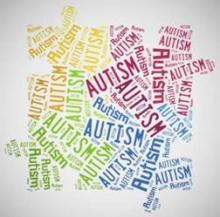User login
Developmental trajectories in preschool children with autism spectrum disorder are highly heterogeneous, according to findings published Jan. 28 in JAMA Psychiatry.
In a longitudinal study of 421 preschool children recently diagnosed with autism spectrum disorder (ASD), two distinct trajectory groups were found in the domain of symptom severity, and three distinct groups were found for adaptive functioning, reported Dr. Peter Szatmari and colleagues at the University of Toronto’s Hospital for Sick Children.
For symptom severity, 11.4% of children had less severe symptoms and an improving trajectory (P < .05), and 88.6% of children had severe symptoms and a stable trajectory. For adaptive functioning, 29.2% of children had lower functioning and a worsening trajectory, 49.9% had moderate functioning and a stable trajectory, and 20.9% had higher functioning and an improving trajectory (P < .05), Dr. Szatmari and his associates reported (JAMA Psychiatry 2015 [doi:10.1001/jamapsychiatry.2014.2463]).
Children were 39.87 months of age on average at baseline, and were enrolled in the longitudinal, multisite Pathways in ASD Study across multiple sites in Canada. Eligibility criteria were age between 2 years and 4 years 11 months, a clinical ASD diagnosis within the last 4 months confirmed by the Autism Diagnostic Observation Schedule (ADOS) and the Autism Diagnostic Interview-Revised, and a DSM-IV diagnosis.
Adaptive functioning trajectory was assessed using composite scores from the Vineland Adaptive Behavior Scales, Second Edition. Symptom severity was assessed using the ADOS calibrated severity score. Data for adaptive functioning was collected at baseline, after 6 months, after 12 months, and at 6 years. Symptom severity data was collected at all points except for the 12-month mark.
Sex was a significant predictor of autistic symptom trajectory, with boys more likely to belong to the group with severe symptoms and a stable trajectory (P = 0.03), the investigators reported. Earlier age at diagnosis was associated with membership in the improving and higher functioning groups (P = 0.02).
“These findings have important implications for surveillance and early identification efforts,” the authors said, and improving a child’s trajectory may need to begin before official diagnosis, “when children manifest behavioral or functional concerns during an at-risk or prodromal phase,” they added.
Once ASD is diagnosed, “It is imperative that a flexible suite of interventions should then be implemented and tailored to each child’s strengths and difficulties,” the investigators said.
The study was funded by the Canadian Institutes of Health Research, NeuroDevNet, Autism Speaks, the Government of British Columbia, the Alberta Innovates Health Solutions, and the Sinneave Family Foundation. The investigators reported no conflict of interest disclosures.
Developmental trajectories in preschool children with autism spectrum disorder are highly heterogeneous, according to findings published Jan. 28 in JAMA Psychiatry.
In a longitudinal study of 421 preschool children recently diagnosed with autism spectrum disorder (ASD), two distinct trajectory groups were found in the domain of symptom severity, and three distinct groups were found for adaptive functioning, reported Dr. Peter Szatmari and colleagues at the University of Toronto’s Hospital for Sick Children.
For symptom severity, 11.4% of children had less severe symptoms and an improving trajectory (P < .05), and 88.6% of children had severe symptoms and a stable trajectory. For adaptive functioning, 29.2% of children had lower functioning and a worsening trajectory, 49.9% had moderate functioning and a stable trajectory, and 20.9% had higher functioning and an improving trajectory (P < .05), Dr. Szatmari and his associates reported (JAMA Psychiatry 2015 [doi:10.1001/jamapsychiatry.2014.2463]).
Children were 39.87 months of age on average at baseline, and were enrolled in the longitudinal, multisite Pathways in ASD Study across multiple sites in Canada. Eligibility criteria were age between 2 years and 4 years 11 months, a clinical ASD diagnosis within the last 4 months confirmed by the Autism Diagnostic Observation Schedule (ADOS) and the Autism Diagnostic Interview-Revised, and a DSM-IV diagnosis.
Adaptive functioning trajectory was assessed using composite scores from the Vineland Adaptive Behavior Scales, Second Edition. Symptom severity was assessed using the ADOS calibrated severity score. Data for adaptive functioning was collected at baseline, after 6 months, after 12 months, and at 6 years. Symptom severity data was collected at all points except for the 12-month mark.
Sex was a significant predictor of autistic symptom trajectory, with boys more likely to belong to the group with severe symptoms and a stable trajectory (P = 0.03), the investigators reported. Earlier age at diagnosis was associated with membership in the improving and higher functioning groups (P = 0.02).
“These findings have important implications for surveillance and early identification efforts,” the authors said, and improving a child’s trajectory may need to begin before official diagnosis, “when children manifest behavioral or functional concerns during an at-risk or prodromal phase,” they added.
Once ASD is diagnosed, “It is imperative that a flexible suite of interventions should then be implemented and tailored to each child’s strengths and difficulties,” the investigators said.
The study was funded by the Canadian Institutes of Health Research, NeuroDevNet, Autism Speaks, the Government of British Columbia, the Alberta Innovates Health Solutions, and the Sinneave Family Foundation. The investigators reported no conflict of interest disclosures.
Developmental trajectories in preschool children with autism spectrum disorder are highly heterogeneous, according to findings published Jan. 28 in JAMA Psychiatry.
In a longitudinal study of 421 preschool children recently diagnosed with autism spectrum disorder (ASD), two distinct trajectory groups were found in the domain of symptom severity, and three distinct groups were found for adaptive functioning, reported Dr. Peter Szatmari and colleagues at the University of Toronto’s Hospital for Sick Children.
For symptom severity, 11.4% of children had less severe symptoms and an improving trajectory (P < .05), and 88.6% of children had severe symptoms and a stable trajectory. For adaptive functioning, 29.2% of children had lower functioning and a worsening trajectory, 49.9% had moderate functioning and a stable trajectory, and 20.9% had higher functioning and an improving trajectory (P < .05), Dr. Szatmari and his associates reported (JAMA Psychiatry 2015 [doi:10.1001/jamapsychiatry.2014.2463]).
Children were 39.87 months of age on average at baseline, and were enrolled in the longitudinal, multisite Pathways in ASD Study across multiple sites in Canada. Eligibility criteria were age between 2 years and 4 years 11 months, a clinical ASD diagnosis within the last 4 months confirmed by the Autism Diagnostic Observation Schedule (ADOS) and the Autism Diagnostic Interview-Revised, and a DSM-IV diagnosis.
Adaptive functioning trajectory was assessed using composite scores from the Vineland Adaptive Behavior Scales, Second Edition. Symptom severity was assessed using the ADOS calibrated severity score. Data for adaptive functioning was collected at baseline, after 6 months, after 12 months, and at 6 years. Symptom severity data was collected at all points except for the 12-month mark.
Sex was a significant predictor of autistic symptom trajectory, with boys more likely to belong to the group with severe symptoms and a stable trajectory (P = 0.03), the investigators reported. Earlier age at diagnosis was associated with membership in the improving and higher functioning groups (P = 0.02).
“These findings have important implications for surveillance and early identification efforts,” the authors said, and improving a child’s trajectory may need to begin before official diagnosis, “when children manifest behavioral or functional concerns during an at-risk or prodromal phase,” they added.
Once ASD is diagnosed, “It is imperative that a flexible suite of interventions should then be implemented and tailored to each child’s strengths and difficulties,” the investigators said.
The study was funded by the Canadian Institutes of Health Research, NeuroDevNet, Autism Speaks, the Government of British Columbia, the Alberta Innovates Health Solutions, and the Sinneave Family Foundation. The investigators reported no conflict of interest disclosures.
FROM JAMA PSYCHIATRY
Key clinical point: The developmental trajectory of symptom severity and adaptive functioning varies in preschool children with autism spectrum disorder.
Major finding: For symptom severity, 11.4% of children had less severe symptoms and an improving trajectory (P < .05), whereas 88.6% of children had severe symptoms and a stable trajectory. For adaptive functioning, 29.2% of children had lower functioning and a worsening trajectory, 49.9% had moderate functioning and a stable trajectory, and 20.9% had higher functioning and an improving trajectory (P < .05).
Data source: An analysis of symptom severity and adaptive functioning in 421 Canadian preschool children diagnosed with autism spectrum disorder.
Disclosures: The study was funded by the Canadian Institutes of Health Research, NeuroDevNet, Autism Speaks, the Government of British Columbia, the Alberta Innovates Health Solutions, and the Sinneave Family Foundation. The investigators reported no conflict of interest disclosures.


